Alkenes and Alkynes – Prelude to Electrophilic Addition
Atomic Hybridization & Molecular Orbitals
What is Atomic Hybridization?
It’s often said that carbon is special because it can form four bonds. It does so by orbital and atomic hybridization. While that is true of carbon, other atoms can certainly form four bonds. The important distinction is that carbon forms four strong, stable bonds.
On the other hand, the real point of this topic, is that hybridization applies to all atoms that form bonds (transition metals—which we don’t care about yet—to ligands are dative bonds and a different type of covalent bond entirely). A dative bond (also called a coordinate covalent bond) is the sharing of a pair of electrons in which all the electrons originate from just one atom.
It is not about how many bonds carbon can form but how many “things”, or groups to which it can attach that usually determines atomic hybridization and therefore, molecular geometry. Except in the course of reactions, it almost always forms four bonds except as unstable intermediates like carbocations or free radicals—it will do what is needed to achieve an octet of electrons and emulate the noble gas configuration. When carbon doesn’t form 4 bonds, it is predisposed to perform a reaction of some kind:
All atoms want to have filled orbitals. The octet rule is explained by this tendency and the rule, which applies only to the second group makes it not much of a rule but an exception. In this course, it is important.
The octet rule is essential in this course in ways you may not realize yet. In mechanisms, every arrow you draw must not violate the octet rule without additional bond-breaking arrows. If those are omitted, you will make mistakes and lose marks.
Part of the reason the drawings below may seem foreign or hieroglyphic at this point is you should have an understanding of what these lines and letters actually abbreviate. When you start doing reactions you want to understand well the hybridizations and geometries of the reacting species. This is essential for picking up the skill of drawing reaction mechanism for Electrophilic Addition rapidly (shown in part below).
The noble or “inert” gases possess this kinetically favorable state of having all its valence orbitals filled. Everything else is potentially reactive.
Anthropomorphic verbs like “desire“, “want“, “makes happier“, “attacks” etc, are human behaviors and those tendencies are projected on non-sentient atoms and molecules mainly because this kind of language is expedient and makes basic sense.
The absence of all filled orbitals leads to kinetic instability that causes chemical change and reactivity.
This is the essence of mechanistic chemical change and the analogy in chemistry is that of atoms wanting, desiring, and yes, stalking something. Most notably are the “-philes” or seekers of other species ease the burden of charge whether it is a deficit or an excess.
Atomic hybridization is atomic geometry and based on how many ‘ligands’ (groups) or atoms to which a central atom is attached by hybridized orbitals.
*There is an exception to this rule which should be mentioned at the start, not later and we’ll get to it.
What is hybridization?
Hybridization and general principles explain how covalent bonding in organic chemistry is possible. Much of it is explained but is complicated. Part of the reason is that it is a oversimplification but a useful model.
An emphasis on hybridization is necessary as it is central to drawing and imagining molecules. A firm grasp as one progresses and it gets easier like a chore, not a perforating brain aneurysm. First, let’s consider alkenes and alkynes for what they are: functional groups or ‘functionality.’ Things will happen there.
It’s essential to understand what alkenes and alkynes actually are composed of.
Carbon and the other second elements can have no more than three geometries: only sp3, sp2 and sp It’s not “s-p-one”. Chemists like to omit the number one when it is obvious how many there are. Tetrahedral, trigonal planar, and linear. It is critical to make all your drawings as precise as possible in the angles between atoms in particular.
Biological life is complex but the atoms it comes from are the simplest.
Starting with hydrogen, one can increase the proton count or atomic number (Z) of an element by adding one proton at a time, starting from hydrogen. That proton or positively charged particle would be accompanied by an electron to balance the charge. Both increase in number in single increments.
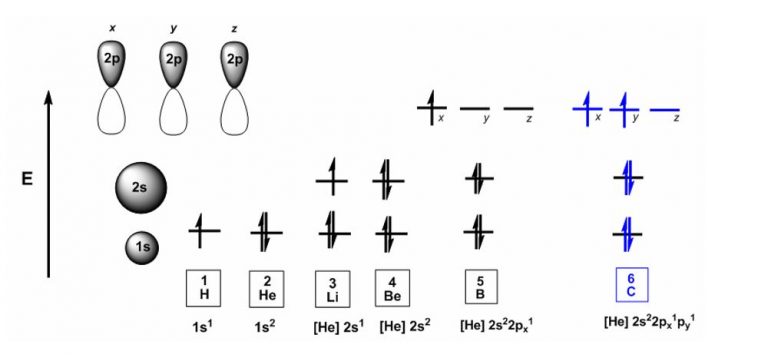 Carbon with six protons has six electrons in the ground state (in blue) above and does not appear like it has 4 unpaired electrons to make 4 bonds. That’s the centrality of carbon, it forms four bonds that can create the right kinds of structures, mainly asymmetrical ones and while many atoms can make 4 bonds, only carbon makes sufficiently long-lived ones.
Carbon with six protons has six electrons in the ground state (in blue) above and does not appear like it has 4 unpaired electrons to make 4 bonds. That’s the centrality of carbon, it forms four bonds that can create the right kinds of structures, mainly asymmetrical ones and while many atoms can make 4 bonds, only carbon makes sufficiently long-lived ones.
For the bonding model of interest, we have to use an approximation (there are two) in the familiar theory, we say we are promoting an electron from the 2s to the 2p energy level. That gives one s and three p orbitals, singly filled. After mixing or a type of homogenization of the 1 s and 3 p electrons they become 4 equal and equivalent unpaired and hybridized electrons as shown below.
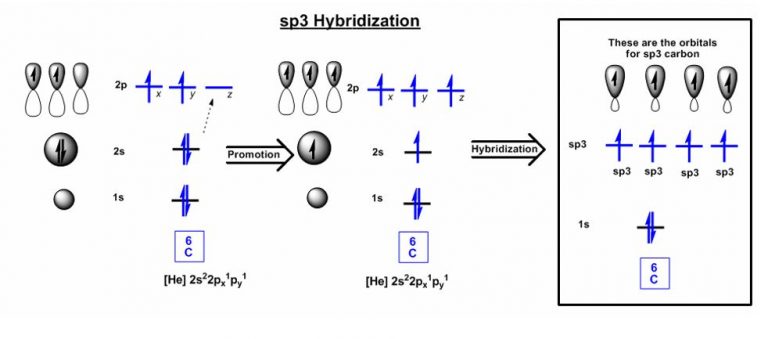 These electrons then mix together with other atoms with these 4 equivalent (they are quantized or come in the same discrete packet of energy) mixed electrons the bonds are all of equal length and of uniform distance from one another. Like chocolate cake for example is an “s electron” and vanilla cake are “p electrons” mixed together one would get a cake that’s all 75% vanilla no matter where you slice it since s + p + p + p = sp3. Each electron has ¼ or 25% s character. Some chemists speak only of s-character and others of p-character. It doesn’t make a difference until there are discussions of acidity.
These electrons then mix together with other atoms with these 4 equivalent (they are quantized or come in the same discrete packet of energy) mixed electrons the bonds are all of equal length and of uniform distance from one another. Like chocolate cake for example is an “s electron” and vanilla cake are “p electrons” mixed together one would get a cake that’s all 75% vanilla no matter where you slice it since s + p + p + p = sp3. Each electron has ¼ or 25% s character. Some chemists speak only of s-character and others of p-character. It doesn’t make a difference until there are discussions of acidity.
This means a mixing or combination process is necessary. Like you get 4 slices of marble cake (electrons hybridized and bearing both s and p character) from 1 slice of s and 3 slices of p to make the angles 109.5o. This is an important angle to remember.
 Either way, the important thing to realize is the number of electrons that end up getting mixed or hybridized determine the geometry of all the spn orbitals. Not all four do.
Either way, the important thing to realize is the number of electrons that end up getting mixed or hybridized determine the geometry of all the spn orbitals. Not all four do.
Carbon can form bonds and how it can form double bonds, and triple bonds are based on this mixing. It is not a reaction…whether they do this or not in reality is not in question, it is a theory that simplifies the complexity of covalent bonding that works and is useful for communicating. All 4 of the sp3 orbitals point away from the carbon at 109.5o, an important number.
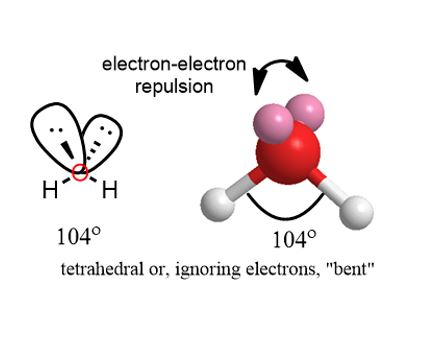 The VSEPR guidelines from General Chemistry is that attachments to an atom are made with the greatest angle between them. This is how we obtain these geometries. The oxygen in water is essentially tetrahedral. Since it is only singly-bonded, it must be sp3 and have angles that approximate 109.5. It does but since oxygen has two lone pairs of electrons that are diffuse (larger). These larger orbitals occupy greater volumes than covalent bonds to hydrogen, when only the geometry of bonds is considered, it is called bent. Organic chemists care about all attachments, particularly lone pairs of electrons.
The VSEPR guidelines from General Chemistry is that attachments to an atom are made with the greatest angle between them. This is how we obtain these geometries. The oxygen in water is essentially tetrahedral. Since it is only singly-bonded, it must be sp3 and have angles that approximate 109.5. It does but since oxygen has two lone pairs of electrons that are diffuse (larger). These larger orbitals occupy greater volumes than covalent bonds to hydrogen, when only the geometry of bonds is considered, it is called bent. Organic chemists care about all attachments, particularly lone pairs of electrons.
Trigonal planar geometry:
For three attachments like in doubly bonded carbons, the most stable is trigonal planar geometry. Not all the electrons are mixed. Only three combined and hybridized.
All the Csp2-H1s bonds are co-planar. Since both carbon atoms have the same hybridization, the other side has the same thing so as the two adjacent sp2 carbons each have a p orbital containing an electron.
The overlap of orbitals containing electrons is known as a bond. These unhybridized electrons in p orbitals and the single electron contained in both atoms constitutes what is called a pi-bond or “double” bond. This overlap of orbitals is not maximal and is thus weaker. The inter-nuclear distance is the same but the node prevents maximal orbital overlap. The pi bond is weaker than a single bond, making it a reactive center in a molecule. This is important and is continually reinforced.
All the other bonds are the traditional single or “sigma” bonds like in H2. In covalent bonding therefore, there are only sigma and pi bonds that matter. Don’t assume there are bonds between higher energy d orbitals in heavier elements. This occurs in the heavier and more metallic elements that can expand beyond an octet like the transition metals but is beyond the scope of this course.
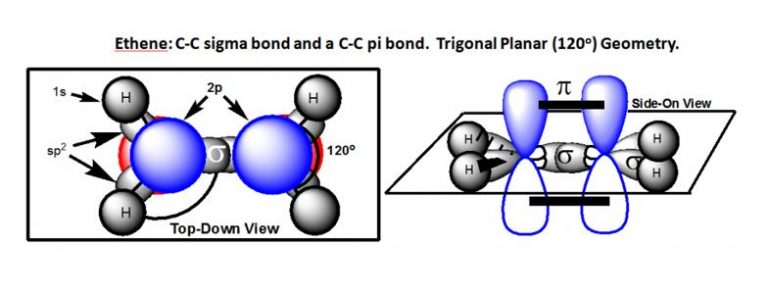 When atoms are linear they have sp hybridization.
When atoms are linear they have sp hybridization.
And last but not least are sp atoms. As you might have already guessed, in ethyne (or acetylene) the simplest alkyne, hybridization follows the trend from sp3 to sp2 to just “sp” (not “sp-one”).
Thus, only two electrons will hybridize in an sp carbon, so ethyne can only form two attachments or bonds (a lone pair counts as an attachment—look at its geometry). The remaining elections are in two unhybridized p orbitals that overlap to form not just one, but two overlapping p orbitals must be on sp2 carbon or other atom (almost always, N, O, and S), π-bonds perpendicular to each other. In organic chemistry we say they are orthogonal (little to no orbital overlap). One sigma plus two π-bonds therefore equals a triple bond (like an alkyne).
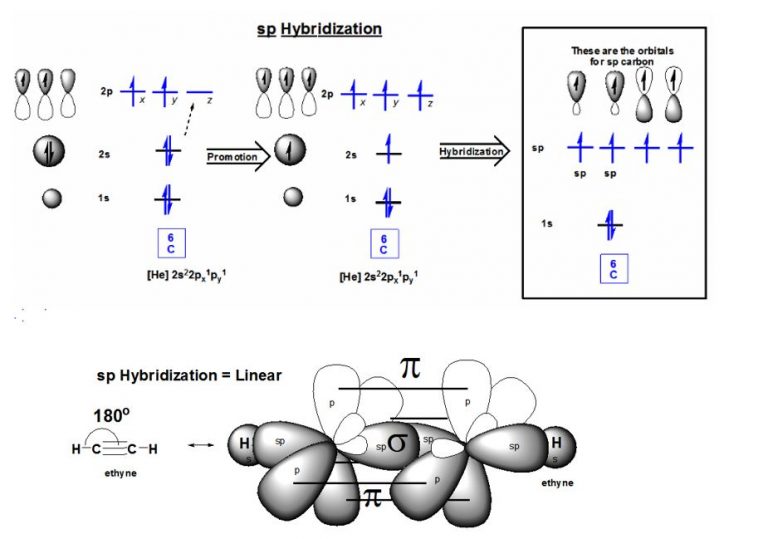 Since a triple bond (one single and two pi bonds) is linear, the unhybridized p orbitals are perpendicular to each other. The more s-character you have, the more spherical you are. The spherical orientation of an orbital means that if an electron has more electron density around it (has more s-character). That means it is s + p = 1.0. The triple bonded carbon has 50% s character.
Since a triple bond (one single and two pi bonds) is linear, the unhybridized p orbitals are perpendicular to each other. The more s-character you have, the more spherical you are. The spherical orientation of an orbital means that if an electron has more electron density around it (has more s-character). That means it is s + p = 1.0. The triple bonded carbon has 50% s character.
“Why does it matter (what will it be used for)?”
Acidity.
The more electronegative you are, the more likely you are to give up (donate) a proton. It has to do with stability once you lose a proton. Then you are a base, now. If you donate a proton you are, by definition, an acid. (A Bronsted acid). And the base formed is weak.
Recall there is a characteristic that varies by element known as electronegativity. And if people remember any trends at all they remember electronegativity first. One would think that a more obvious trend like atomic radius would be more memorable. What is the definition of electronegativity?
The capacity to hold electrons as close to the nucleus as possible, is an element’s electronegativity, it is part of chemical intuition. But it doesn’t hold them really, it works in a way that is both statistically and mechanically, a probability function (χ2).
The point is that the closer you are in character to a sphere (an s orbital), the more electronegative you are since they would as close as possible to the nucleus. P character has no statistical probability of finding an electron (remember, they are quantized or discrete packets of matter) close the nucleus and in this way negate or subtract s-character. (s + p = 50% s 50% p = 1.0). An sp hybridized atom is more electronegative and is correspondingly more acidic than an sp2 orbital (33% s-character) or an sp3 orbital (25% s-character).
Resonance.
You must spot p orbitals to know where you can and cannot draw resonance arrows.
Drawing.
Remember to draw structures with the correct geometry. If asked to draw everything like the overview above, even something small would take up the entire page. We draw in abbreviations of the shorthand just mentioned.
 One must strive to maintain the bond angles and geometry in drawing just like the structures corresponding to the hybridization state. It’s important not to lose points for the simple things.
One must strive to maintain the bond angles and geometry in drawing just like the structures corresponding to the hybridization state. It’s important not to lose points for the simple things.
In general, if a (second row) atom is singly bonded to 4 things (things are atoms OR lone pairs), it is sp3, if it is bonded to 3 things (s + p + p +p), it’s sp2 (s + p + p), and to two things it’s sp (s+p).
To Complicate Things a Teensy Bit with a crucial exception:
***Atoms that appear to have the usual four groups on them are not always sp3 but will be sp2 hybridized.***
HOW & WHY?
Consider the following:
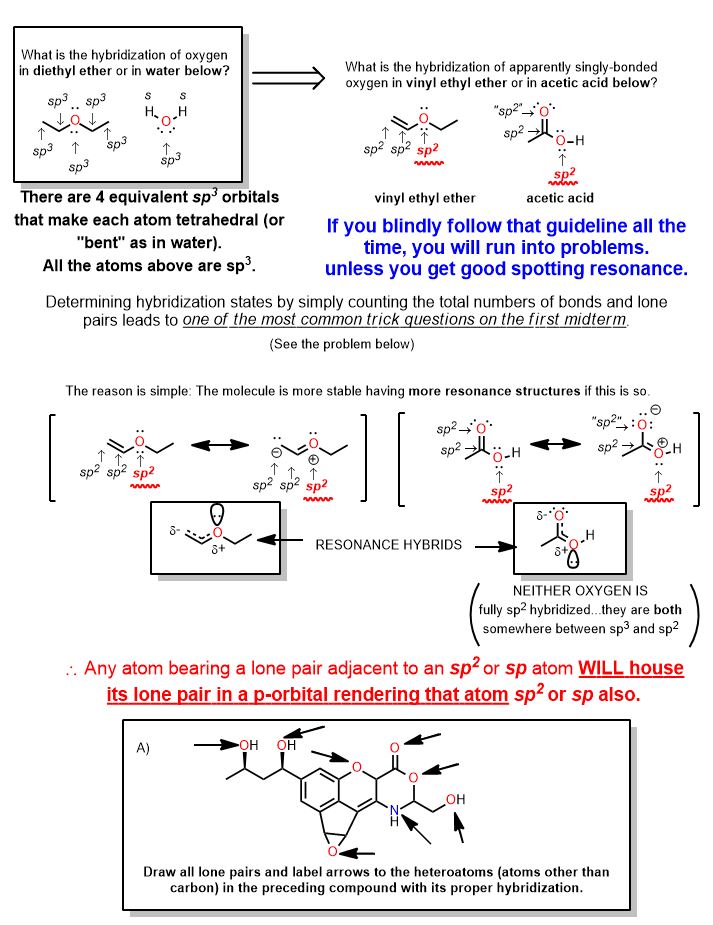 When an atom has a lone pair and is next door to a p-orbital-containing atom, that atom will:
When an atom has a lone pair and is next door to a p-orbital-containing atom, that atom will:
- Have a bond order greater than 1
- Also be sp2 (trigonal planar), and will
- Increase the thermodynamic stability of the entire molecule by resonance stabilization (via electron delocalization).
Let’s review so we’re clear on this.
A word about sp3 Hybridization:
The natural question then is how and why does carbon form four bonds? Based on its electron configuration, it shouldn’t form four bonds of equal length and strength.
Hybridization as a conceptual device is simpler than the long and protracted theory behind it. Just accept it. You will only prolong the inevitable, by challenging acceptance of this simplifying fact. Accepting it as true (a bit of memorization) will allow you to understand the geometry of an atom and its behavior the same as you have accepted a great deal of theoretical physics and chemistry without the necessary background to reasonably do so.
The proof of most things and the experiments that led to these conclusions are rarely discussed. Certainly don’t dwell on it longer than needed. You can start from the beginning like all textbooks do and reach the conclusion that carbon can and does make four bonds to different numbers of atoms. But it requires some seemingly contradictory assumptions to get there. The mixing of one 2s and three 2p electrons gives you four equivalent other kinds of orbital: sp-type hybrids with characteristics of both.
Textbooks begin with aufbau theory, the principle of building up the elements of the periodic table by adding a proton and an electron to an atom one at a time and an increase in atomic number. The number of protons in the nucleus (Z) determines what element you have. As you do this thought experiment, (we don’t build anything, it’s just this way and a convenient method of electron bookkeeping).
Hydrogen has one, helium has two, lithium three, and so on. As shells become filled, two at a time, it is necessary to enter higher energy shells and subshells. This is in every textbook, and doing things this way doesn’t necessarily answer any questions about atomic hybridization. In fact, it makes the concept of hybridization more mysterious.
Just accept it as it is: the 4 equivalent orbitals sp3 orbitals form four σ bonds and starting with what we know we work from those observations. It’s more practical. There is one main conclusion to reach at this point anyway. Having seen the several ways to write in representing the structure of an organic compound, we could represent all compounds with the atomic orbitals overlapping (to form bonding-molecular orbitals) however, this would be time-consuming and is too realistic. We draw lines for bonds and letters for nuclei for expediency.
Carbon can be attached to four things (usually sp3), three things (sp2) or just two, (sp).
The atoms in the second row of the right side of the periodic table are the most non-metallic. These are the atoms we manipulate in organic. An example will help. The molecule methane is a greenhouse gas, it is a major component in the natural or heating gas in furnaces and also causes flatulence to ignite in the presence of a catalyst. Methane is odorless and colorless. In natural gas however, where leaks can be deadly, it’s intentionally contaminated with a trace of sulfur compound (ethanethiol) so it can be easily detected in case of a gas leak. The rectum smells fetid and the methane carried out takes airborne fecal material to the noses of others. The three hybridizations roughly equate to singly, doubly, and triply bonded atoms.
A Word About Drawing and Representation:
Butane, for example is an alkane like methane with 4 carbons. It is a chain of carbons with nothing but single (σ) bonds to hydrogen (more precisely, it’s saturated with them). It can be and is written in the following ways during your introduction to the subject. It is easiest at the beginning to understand what you are dealing with and supposedly seeing.

You can draw out each and every atom and bond like the Kekulé structure on the left. This is tedious for just four carbons. Like certain other things, it’s shown to you at the beginning but one will never have to do this all the time. No one is trying to drive you insane, intentionally anyway.
Imagine drawing something with eight carbons in this manner, things with branching in this fashion and you will hate the subject from day one. Alternatively you can use the condensed formula in the middle and have no geometry at all, but save space.
The condensed formula is slightly less tedious than the first but only at the beginning. It becomes difficult to understand or translate these letters and numbers to paper when the molecules become larger and more complex as they will inevitably.
For example, draw (CH3CH2CH2)2CHC(O)CHOHC(CH3)2(C5H6). That’s this: 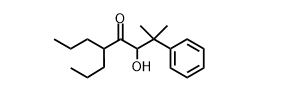
It becomes clear why organic chemists restrict their use these condensed formulas when dealing with a small number like two or one carbon. You should recognize just by glancing at a skeletal drawing how many implicit hydrogen atoms there are. To lack this skill will do you serious damage later on, so start early. To fill an octet requires 4 attachments or bonds. Even when doubly and triply-bonded, the number of bonds in a stable carbon compound will be four.
A related matter is determining whether a carbon is primary (1o); secondary (2o), tertiary (3o), or quaternary (4o) and is the number of carbons to which a specific carbon is attached. The point is, the amount of substituents will also suggest to you how many hydrogen atoms are present even though their not drawn. The number of hydrogens is just the number of missing bonds to other carbons…a primary carbon has 3, a secondary has 2, a tertiary has 1, and a quaternary, well, none.
Hybridization tells us the atom’s geometry and, by extension, if you want to get good, there is a right way and a wrong way to draw organic compounds. The correct way is to emulate the 3-D shape and ignore the atomic symbols when H is attached to C. On atoms other than carbon, both the hydrogens and the heteroatom symbols are written out. The skeletal drawing on the far right is how organic chemists draw because it’s expedient and more clear. It may take practice, but is to your advantage. See how there are 4 carbons in that series of only three lines? Do not count lines when drawing, those each represent the bond between two atoms and will cause mistakes (extra carbons). Similarly, if you count the lines, you will end up with one fewer carbon. Number the atoms, count as you point to each one, whatever it takes to not make counting errors.
I have seen second-semester students write structures like this because they were encouraged to by their instructor! –> C-C-C-C-C-C (this is supposedly hexane!). Please do not form this terrible habit. There is no such representation as that and it makes your grader think you 1) can’t just count or draw and 2) you’ll lose the benefit of the doubt on your “iffy” questions.
*Further, the key to not making simple mistakes is to not draw on top of what you’ve already drawn. Number carbons if you have to (you have to or you will have to eventually). If you think that numbering is somehow “beneath” you, you will pull your hair out when your test is full of mostly counting errors.
Do not count by visual inspection. Does anyone count money that way?…and these are just lines. Which reminds me…don’t count carbons by the number of lines you draw. Why not?
If you intend to add substituents, draw new bonds (lines) coming off the structure you’ve already completed like the parent chain. Then write the symbol at the end of it.
Organic chemistry is three-dimensional and geometry comes from hybridization. The best or closest way to drawing a carbon bonded to four things on paper is the wedge/dashed-line drawing. When the atoms we are concerned with are attached to 4 atoms or groups they are usually sp3 hybridized and have tetrahedral geometry around them (a tetrahedron is a pyramid with a triangular base). The H-C-H bond angles in methane are all the same, 109.5o.
The wedge means the bond is coming toward you. The dashed-line, in contrast, means the bond is pointing backward. So, even in two dimensions, we can represent the hydrogen atom as behind the plane of the screen without a great deal of artistry. The other two bonds are in the plane of the page.
This representation combined with the skeletal formula is the most common and most important way to do all your drawing. Of course, methane is one carbon and can’t be drawn skeletally (a dot?). All the carbon atoms in butane (above) are tetrahedral. They even named a journal (a prestigious one) Tetrahedron; and the first Nobel prize was awarded for proving it is tetrahedral and not a square and that it could be chiral.
Trigonal planar and linear atoms in reactions of alkenes and alkynes is found on its corresponding page.
 To Be Continued…
To Be Continued…
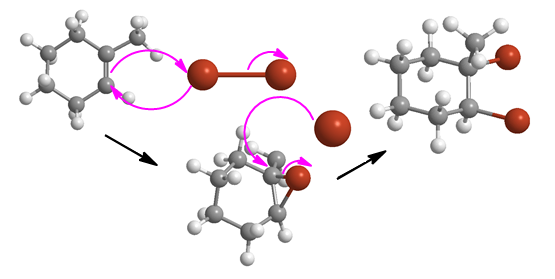
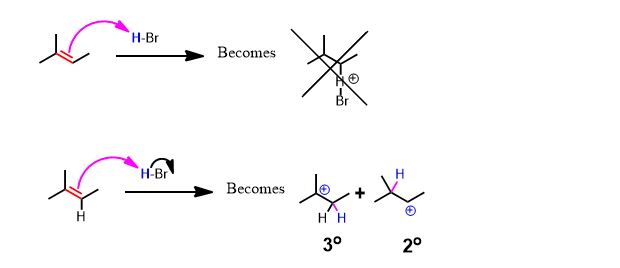
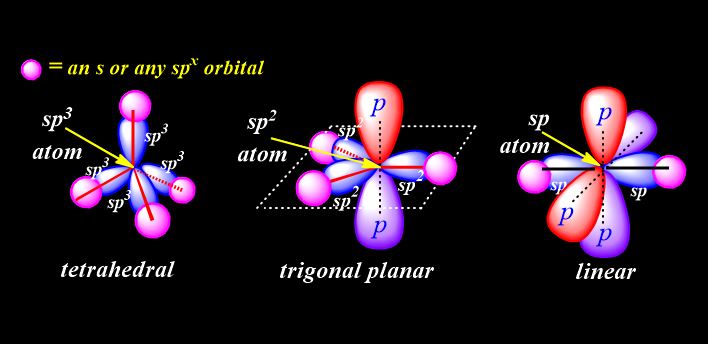
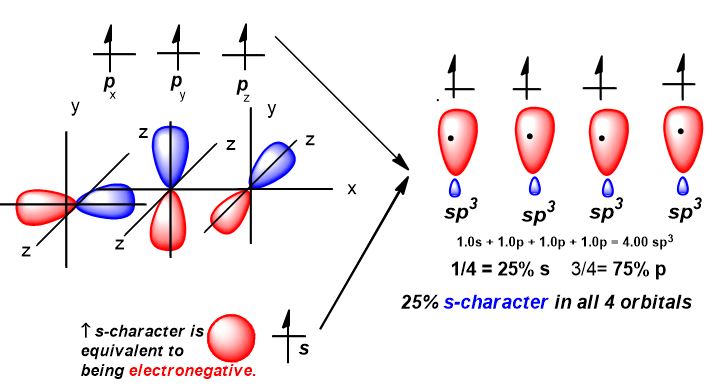
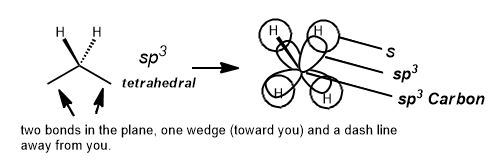
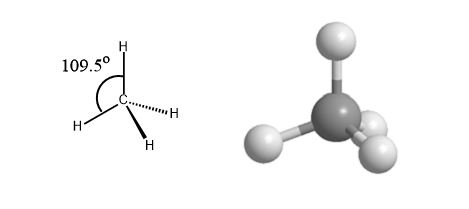


Leave a Reply
You must be logged in to post a comment.